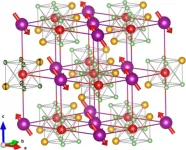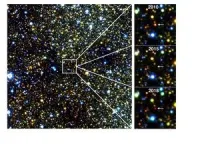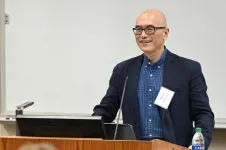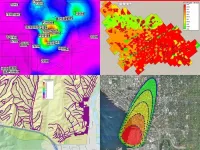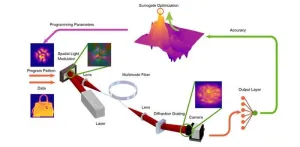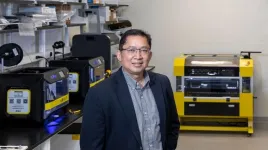(Press-News.org)
Muon spectroscopy is an important experimental technique that scientists use to study the magnetic properties of materials. It is based on “implanting” a spin-polarized muon in the crystal and measuring how its behavior is affected by the surroundings. The technique relies on the idea that the muon will occupy a well-identified site that is mainly determined by electrostatic forces, and that can be found by calculating the material’s electronic structure.
But a new study led by scientists in Italy, Switzerland, UK and Germany has found that, at least for some materials, that is not the end of the story: the muon site can change due to a well-known but previously neglected effect, magnetostriction.
Pietro Bonfà from the University of Parma, lead author of the study just published in Physical Review Letters, explains that his group and their colleagues at the University of Oxford (UK) have been using density-functional theory (DFT) simulations for at least a decade to find muon sites. “We started with tricky cases, such as europium oxide and manganese oxide, and in both cases, we could not find a reasonable way to reconcile DFT predictions and the experiments”, he says. “We then tested simpler systems and we had many successful predictions, but those two cases were really bothering us. These compounds should be easy and instead turned out to be super complicated and we did not understand what was happening. Manganese oxide is a textbook case of an antiferromagnetic system, and we could not explain muon spectroscopy results for it, which was a bit embarrassing”.
The problem, he explains, was the contradiction between the expectation to find the muon in a high symmetry position, and its well-known tendency to make bonds with oxygen atoms. The antiferromagnetic order of the material reduces the symmetry, and the position close to the oxygen atoms becomes incompatible with experiments.
Bonfà suspected that the explanation could be linked to the material undergoing a magnetic phase transition and started trying to reproduce the phenomenon in simulations of manganese oxide. “Because it is a complicated system, you must add some corrections to DFT, such as the Hubbard U parameter” he says. “But we were choosing its value empirically, and when you do that, you have a lot of uncertainty, and the results can change dramatically depending on the value you choose”. Still, Bonfà’s initial simulations suggested that the muon positions could be driven by magnetostriction, a phenomenon that causes a material to change its shape and dimensions during magnetization. To prove it beyond doubt, he teamed up with the MARVEL laboratories at EPFL and PSI of Nicola Marzari and Giovanni Pizzi.
“We used a state-of-the-art method called DFT+U+V, which was very important to make simulations more accurate” explains Iurii Timrov, a scientist in the Laboratory for Materials Simulations at PSI and co-author of the study. This method can be used with onsite U and intersite V Hubbard parameters that are computed from first principles instead of being chosen empirically, thanks to the use of density-functional perturbation theory for DFT+U+V that was developed within MARVEL and implemented in the Quantum ESPRESSO package. “Although we had already figured out that magnetostriction was at play, having the correct information on the building blocks of the simulation was very important, and that came from Iurii’s work” adds Bonfà.
In the end, the solution of the puzzle was relatively simple: magnetostriction, which is the interplay between magnetic and elastic degrees of freedom in the material, causes a magnetic phase transition in MnO at 118K, at which the muon site switches. Above that temperature, the muon becomes delocalized around a network of equivalent sites – which explains the unusual behavior observed in experiments at high temperatures.
The scientists expect that the same may be true also for many other rocksalt structured magnetic oxides. In the future, Timrov explains, the group wants to keep studying the same material also including temperature effects, using another advanced technique developed in MARVEL and called stochastic self-consistent harmonic approximation. In addition, and in collaboration with Giovanni Pizzi’s group at the Paul Scherrer Institute, this approach will be made available to the community through the AiiDAlab interface, so that all experimentalists can use it for their own studies.
END
SAN ANTONIO, Jan. 25, 2024 — It is a far cry from the traditionally thought-of “vegetative state” in which the mind is absent while the body lives on. Indeed, it is the opposite. Children with “locked-in syndrome,” unable to move or speak, are awake and fully aware of their surroundings.
Researchers from The University of Texas Health Science Center at San Antonio (UT Health San Antonio) were the first to report in peer-reviewed medical literature that, after non-fatal drownings, children would be locked in. The team, directed by Peter T. Fox, MD, professor of radiology and neurology and director of UT ...
From the impacts on the environment and climate to transforming land cover and habitats, urban growth is driving global change. Urban areas contribute up to 75% of global greenhouse gas emissions. By 2050, urban areas globally will either double or triple, and the raw materials needed to build future cities is more than the world can sustainably provide.
Yet, the impacts of cities on Earth systems are not factored into policy and planning among international agencies and that needs to change, says Karen Seto, Frederick ...
CHICAGO—January 25, 2024—Illinois Institute of Technology (Illinois Tech) Professor Chun Liu has been elected a 2024 fellow of the American Mathematical Society (AMS)—one of just 40 mathematical scientists to be honored this year for his contribution to mathematics.
“It’s nice to be recognized by my colleagues, but this also gives visibility for the whole department and Illinois Tech,” says Liu, chair of the Department of Applied Mathematics. “It’s great recognition for the mathematics research that’s going on here at Illinois Tech.”
Liu’s research includes partial differential ...
MADISON — People who were more skeptical of human-caused climate change or the Black Lives Matter movement who took part in conversation with a popular AI chatbot were disappointed with the experience but left the conversation more supportive of the scientific consensus on climate change or BLM. This is according to researchers studying how these chatbots handle interactions from people with different cultural backgrounds.
Savvy humans can adjust to their conversation partners’ political leanings and cultural expectations to make sure they’re understood, but more and more often, humans find themselves in ...
RICHLAND, Wash.—Visual Sample Plan (VSP), a free software tool developed at the Department of Energy's Pacific Northwest National Laboratory (PNNL) that boosts statistics-based planning, has been recognized with a 2024 Federal Laboratory Consortium (FLC) Award.
The FLC represents over 300 federal laboratories, agencies, and research centers. The annual FLC awards program recognizes agencies for their contributions to technology transfer, which turns innovative research into impactful products and services.
Judges bestowed ...
Current artificial intelligence models utilize billions of trainable parameters to achieve challenging tasks. However, this large number of parameters comes with a hefty cost. Training and deploying these huge models require immense memory space and computing capability that can only be provided by hangar-sized data centers in processes that consume energy equivalent to the electricity needs of midsized cities. The research community is presently making efforts to rethink both the related computing hardware and the machine learning algorithms to sustainably keep the development of artificial intelligence at its current pace.
Optical implementation ...
Rigoberto “Gobet” Advincula has been awarded one of the highest honors of his profession.
Advincula, the University of Tennessee-Oak Ridge National Laboratory Governor’s Chair of Advanced and Nanostructured Materials, has been elected National Academy of Inventors (NAI) Fellow.
Advincula is a leader in the polymer field with inventions and many publications in polymer nanocomposites, graphene nanomaterials, polymer layered films, and coatings. He has been granted 14 US patents and has 21 published filings related to graphene nanomaterials, solid-state device fabrication, smart coatings and films, ...
AMHERST – University of Massachusetts Amherst researchers have received an award to develop a new type of sweat monitor that can be applied to the skin just like a temporary tattoo and assess the molecules present, such as cortisol. The tattoos will ultimately give individuals better insight into their health and serve as a tool for researchers to discover new early indications of diseases.
“There are a lot of vital biomolecules that are present in sweat that we need to measure to really understand overall human performance and correlation to different ...
Because viruses have to hijack someone else’s cell to replicate, they’ve gotten very good at it—inventing all sorts of tricks.
A new study from two University of Chicago scientists has revealed how HIV squirms its way into the nucleus as it invades a cell.
According to their models, the HIV capsid, which is cone-shaped, points its smaller end into the pores of the nucleus and then ratchets itself in. Once the pore is open enough, the capsid is elastic enough to squeeze through. Importantly, the scientists ...
The 1972 Clean Water Act protects the "waters of the United States" but does not precisely define which streams and wetlands this phrase covers, leaving it to presidential administrations, regulators, and courts to decide. As a result, the exact coverage of Clean Water Act rules is difficult to estimate.
New research led by a team at the University of California, Berkeley, used machine learning to more accurately predict which waterways are protected by the Act. The analysis found that a 2020 Trump administration rule removed Clean Water Act ...
